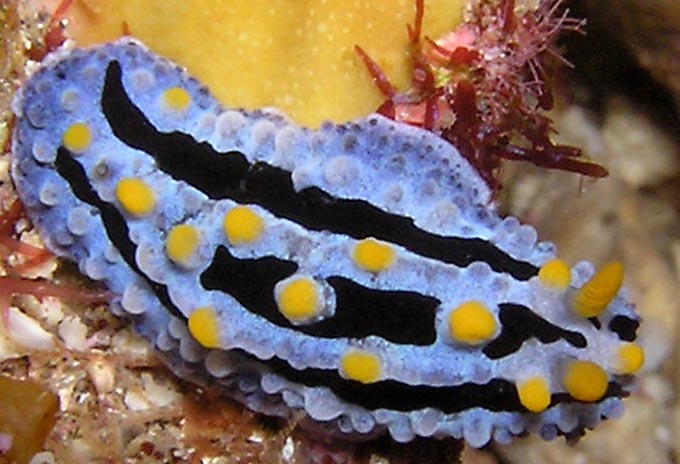This species has been observed on Reunion, Mauritius, Mayotte, Madagascar and Seychelles Islands
Species characteristics : The rhinophores and rhinotubercules are yellow. |

|
|
| Showing species characteristics... | Photo Florence Trentin Reunion, "Eboulis reef" at Saint Leu, 30-35 mm, 18 m, 4 January 2005 |
|
See more about : Sightening and mating periods
See more about : Phyllidia coelestis variability in Southwest Indian ocean
Remarks :
Identification confirmed by Bill Rudman
Synonymous : (according Worms)
- Phyllidia alia Yonow, 1984
Bibliographic data : Material examined by David J.Brunckhorst ( see reference/publications).
Other external morphology characteristics
|
Detail of the mantle. The grey coloration isn't homogenous, but due to the accumulation of tiny spots |
 |
The rhinophores are yellow in colour and each rhinophoral clavus possesses 19 to 26 lamellae
Around the mantle margin is a broad blue-grey band with small tubercles, the larger ones of which may be yellow capped.
The pattern of juveniles appears to be simpler with less variation in the two ridges. These blue grey dorsal ridges are not interrupted in juveniles, and thus form a distinctive “Y” shape on the dorsum .
Other characteristics
Like many Nudibranchs, it eats sponge.
Found on open reef slopes where it is observed on walls in the open to 20 m depth.
Similar species
This species has been confused with Phyllidia varicosa. P. coelestis has a broken black band down the midline and a ridge on each side of it, while in P. varicosa there is a bluish-grey ridge down the midline, with a black band on each side of it. If you can see the sole of the foot then P. varicosa has a median black line and P. coelestis does not.
References :
Bill Rudman Seaslug site : Sea Slug Forum : Phyllidia coelestis
Nudipixel Phyllidia coelestis
Publications :
Brunckhorst, D.J. (1993) The systematics and phylogeny of Phyllidiid Nudibranchs (Doridoidea). Records of the Australian Museum, Supplement 16: 1-107.
Other photos of Phyllidia coelestis :
Florence Trentin Reunion, "Eboulis reef" at Saint Leu, 15 m, 26 December 2006, size 20-22 mm A specimen with numerous yellow capped tubercles and some black spots scattered into the blue-grey margin. |
 |
|
Delphine Dupin Reunion, Saint Leu, 10 October 2004 In this specimen, some black spots are scattered into the blue-grey margin. The medium black longitudinal band is interrupted and only present between the isolated, large, yellow capped tubercles |
Hugues Flodrops Reunion, "Pain de Sucre" at Boucan Canot, 7-8 m, 20 December 2006, size 35 mm. The medium black longitudinal band is partially interrupted at the level of the isolated, large, yellow capped tubercles |
 |
|
Eva Fontaine
mtsanga Mbouéanatsa at Mayotte, on the reef flat zone, less 1 m, 19 July 2008, size 25 mm. A specimen with numerous yellow capped tubercles and a interrupted black longitudinal band |
More photos from Indian Ocean
See more about : Phyllidia coelestis variability in Southwest Indian ocean
Mayotte, a classical pattern for Phyllidia coelestis, at Mbouéanatsa, by Philibert Bidgrain
Mayotte, rhinophore detail of Phyllidia coelestis, at musical plage, by Eva Fontaine
Reunion, a damaged Phyllidia coelestis, at Saint Gilles, by Eva Fontaine
Madagascar, Phyllidia coelestis, at Andavadoaka, by Alain Barrère
Seychelles, Phyllidia coelestis, at Mahé, by Christophe Mason-Parker
Mauritius, Phillydia coelestris, at Flic en Flac by Pierre Périès

